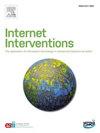心理治疗 2.0 - 传感器技术在儿童和青少年心理治疗中的应用环境和效果:系统回顾
IF 4.1
2区 医学
Q1 HEALTH CARE SCIENCES & SERVICES
Internet Interventions-The Application of Information Technology in Mental and Behavioural Health
Pub Date : 2024-11-06
DOI:10.1016/j.invent.2024.100785
引用次数: 0
摘要
背景几年来,电子心理健康应用越来越多地用于病人的心理治疗。最先进的传感器技术可用于确定诊断精神障碍的数字生物标记。此外,通过将传感器整合到治疗中,相关的背景信息(如注视范围、压力水平)可以变得透明,从而改善对精神障碍患者的治疗。我们对传感器技术在儿童和青少年心理治疗中的应用进行了系统综述,旨在研究感知技术在心理治疗中的应用和效果。我们在五个数据库中搜索了 2000 年至 2023 年的研究。该研究已在 PROSPERO(CRD42023374219)注册,根据 Cochrane 建议进行,并采用了 PRISMA 报告指南。结果在 38.560 次检索中,只有 10 篇出版物符合纳入标准,其中包括 3 项 RCT 和 7 项试点研究,共有 257 名受试者。研究对象包括患有强迫症、焦虑症、创伤后应激障碍、神经性厌食症和自闭症等精神障碍的 6 至 19 岁儿童和青少年。所调查的心理治疗方法主要是认知行为疗法(面对面接触),以及针对各种障碍的暴露治疗方法。在大多数情况下,使用心电图、电子数据采集、眼动跟踪和运动传感器来测量生命参数。这些不同的研究说明了传感器技术在青少年心理治疗中的各种潜在有用应用。在一些研究中,传感器被应用于可行的治疗方法中。结论在不同的应用环境中,传感器可能会丰富心理治疗的内容。然而,迄今为止,仍然缺乏进一步的随机对照临床研究,以提供关于感官疗法在儿童和青少年心理治疗中的有效性的可靠结论。这可以促进将此类技术嵌入心理治疗过程。https://www.crd.york.ac.uk/prospero/display_record.php?ID=CRD42023374219,标识符[CRD42023374219]。本文章由计算机程序翻译,如有差异,请以英文原文为准。
Psychotherapy 2.0 - Application context and effectiveness of sensor technology in psychotherapy with children and adolescents: A systematic review
Background
E-mental health applications have been increasingly used in the psychotherapeutic care of patients for several years. State-of-the-art sensor technology could be used to determine digital biomarkers for the diagnosis of mental disorders. Furthermore, by integrating sensors into treatment, relevant contextual information (e.g. field of gaze, stress levels) could be made transparent and improve the treatment of people with mental disorders. An overview of studies on this approach would be useful to provide information about the current status quo.
Methods
A systematic review of the use of sensor technology in psychotherapy for children and adolescents was conducted with the aim of investigating the use and effectiveness of sensory technology in psychotherapy treatment. Five databases were searched for studies ranging from 2000 to 2023. The study was registered by PROSPERO (CRD42023374219), conducted according to Cochrane recommendations and used the PRISMA reporting guideline.
Results
Of the 38.560 hits in the search, only 10 publications met the inclusion criteria, including 3 RCTs and 7 pilot studies with a total of 257 subjects. The study population consisted of children and adolescents aged 6 to 19 years with mental disorders such as OCD, anxiety disorders, PTSD, anorexia nervosa and autistic behavior. The psychotherapy methods investigated were mostly cognitive behavioral therapy (face-to-face contact) with the treatment method of exposure for various disorders. In most cases, ECG, EDA, eye-tracking and movement sensors were used to measure vital parameters. The heterogeneous studies illustrate a variety of potential useful applications of sensor technology in psychotherapy for adolescents. In some studies, the sensors are implemented in a feasible approach to treatment.
Conclusion
Sensors might enrich psychotherapy in different application contexts.
However, so far there is still a lack of further randomized controlled clinical studies that provide reliable findings on the effectiveness of sensory therapy in psychotherapy for children and adolescents. This could stimulate the embedding of such technologies into psychotherapeutic process.
https://www.crd.york.ac.uk/prospero/display_record.php?ID=CRD42023374219, identifier [CRD42023374219].
求助全文
通过发布文献求助,成功后即可免费获取论文全文。
去求助
来源期刊

Internet Interventions-The Application of Information Technology in Mental and Behavioural Health
Medicine-Health Informatics
CiteScore
6.50
自引率
9.30%
发文量
94
审稿时长
6 weeks
期刊介绍:
Official Journal of the European Society for Research on Internet Interventions (ESRII) and the International Society for Research on Internet Interventions (ISRII).
The aim of Internet Interventions is to publish scientific, peer-reviewed, high-impact research on Internet interventions and related areas.
Internet Interventions welcomes papers on the following subjects:
• Intervention studies targeting the promotion of mental health and featuring the Internet and/or technologies using the Internet as an underlying technology, e.g. computers, smartphone devices, tablets, sensors
• Implementation and dissemination of Internet interventions
• Integration of Internet interventions into existing systems of care
• Descriptions of development and deployment infrastructures
• Internet intervention methodology and theory papers
• Internet-based epidemiology
• Descriptions of new Internet-based technologies and experiments with clinical applications
• Economics of internet interventions (cost-effectiveness)
• Health care policy and Internet interventions
• The role of culture in Internet intervention
• Internet psychometrics
• Ethical issues pertaining to Internet interventions and measurements
• Human-computer interaction and usability research with clinical implications
• Systematic reviews and meta-analysis on Internet interventions
 求助内容:
求助内容: 应助结果提醒方式:
应助结果提醒方式:


